When autumn arrives in Japan, the air turns crisp, the mountains glow with vibrant foliage, and markets are filled with seasonal produce. Among the most iconic fruits of the season is the persimmon, known in Japanese as kaki. With their brilliant orange hue and delicate sweetness, persimmons symbolize the beauty and bounty of autumn in Japan. More than just a seasonal fruit, persimmons are deeply embedded in Japanese history, daily life, culinary traditions, and even cultural expressions, making them a unique window into the heart of Japanese autumn.
When the air turns crisp and the leaves begin to fall, persimmons appear across Japan as a seasonal treasure enjoyed for centuries.
Historical and Cultural Significance
Persimmons have been cultivated in Japan for over a thousand years. Historical records indicate that persimmon trees were planted in temple gardens and rural areas during the Nara period (710–794). They were not only valued as food but also appreciated for their aesthetic appeal. The sight of ripe persimmons hanging from branches after the leaves have fallen has been immortalized in Japanese poems, paintings, and haiku.
Persimmons also symbolize longevity and good health, partly due to their nutritional benefits. Rich in vitamin C, potassium, and fiber, they were historically dried or stored to provide nourishment through the winter months. In rural Japan, strings of drying persimmons hanging from the eaves of houses—called hoshigaki—are a quintessential autumn scene, representing both practicality and beauty.
Fresh Persimmons in Everyday Life
There are two main types of persimmons in Japan: amagaki (sweet persimmons) and shibugaki (astringent persimmons).
- Amagaki are enjoyed raw, sliced into wedges, and served as a refreshing snack or dessert. Their smooth, honey-like sweetness makes them a favorite among children and adults alike.
- Shibugaki, on the other hand, are too astringent to eat raw. Instead, they are transformed into hoshigaki, where the drying process concentrates their sugars and gives them a chewy, candy-like texture.
In autumn, persimmons are often given as gifts, elegantly packaged and shared with friends, relatives, or colleagues. They embody the spirit of omotenashi, or Japanese hospitality, reflecting thoughtfulness and seasonal awareness.
Persimmons in Japanese Cuisine
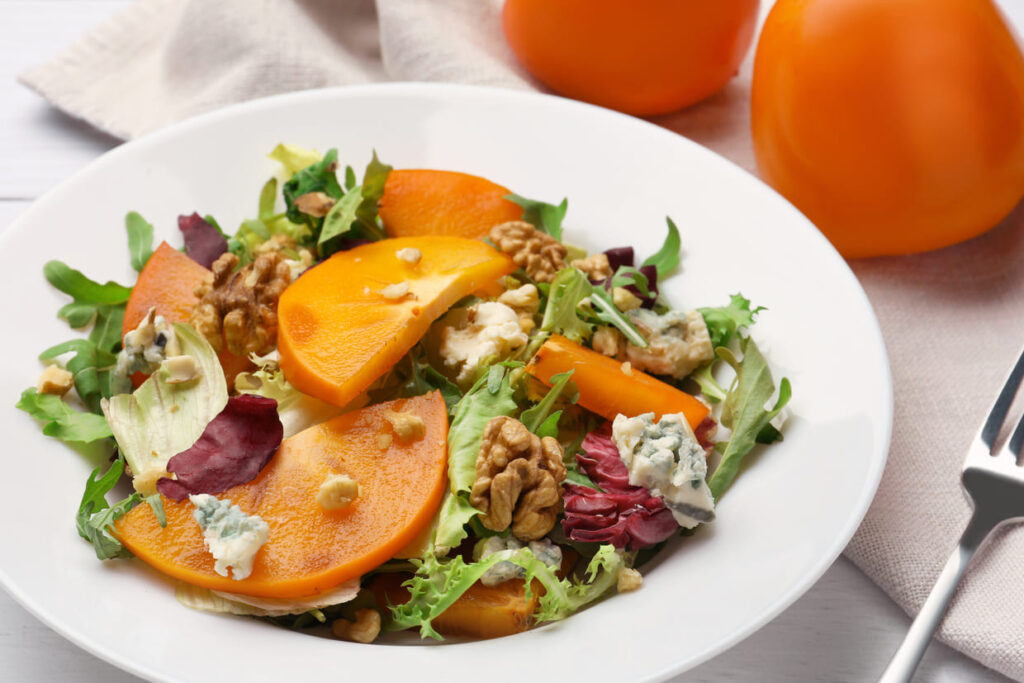
Beyond eating them fresh, persimmons appear in a variety of Japanese dishes.
- Kaki Salad: Fresh slices of persimmon are combined with daikon radish, mizuna greens, or even tofu, creating a refreshing balance of sweetness and crunch.
- Sunomono with Kaki: Persimmons are sometimes used in vinegared dishes, where their sweetness offsets the tart dressing.
- Kaki no Shiraae: A traditional dish where persimmons are mixed with tofu, sesame paste, and miso, creating a sweet-savory harmony that highlights the Japanese love of subtle flavor balance.
In rural areas, persimmons have also been incorporated into pickles and preserves. Their natural sweetness makes them versatile, bridging the gap between fruit and vegetable in the culinary imagination of Japan.
Hoshigaki: The Art of Dried Persimmons
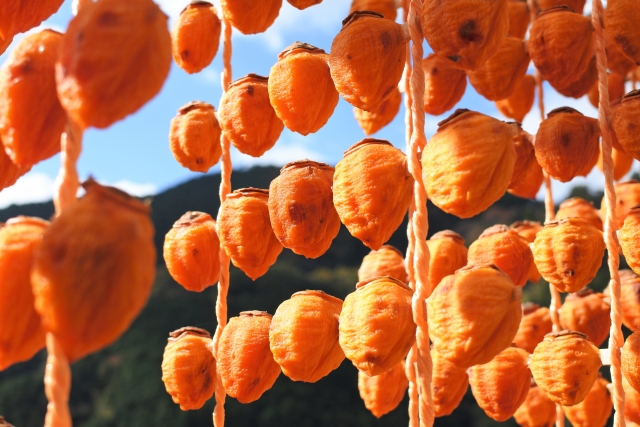
One of the most fascinating aspects of persimmon culture in Japan is the making of hoshigaki (dried persimmons). This process is as much an art as it is a method of preservation. Astringent persimmons are peeled, tied with strings, and hung in rows under the eaves of houses or special drying racks. Over several weeks, the fruit gradually shrinks, its sugars intensify, and a natural white coating of sugar crystals forms on the surface.
The result is a chewy, sweet delicacy with a depth of flavor that rivals fine confectionery. Hoshigaki are often enjoyed with green tea or used as offerings at shrines during New Year celebrations. They embody the Japanese values of patience, craftsmanship, and respect for natural processes.
Persimmons in Wagashi and Sweets
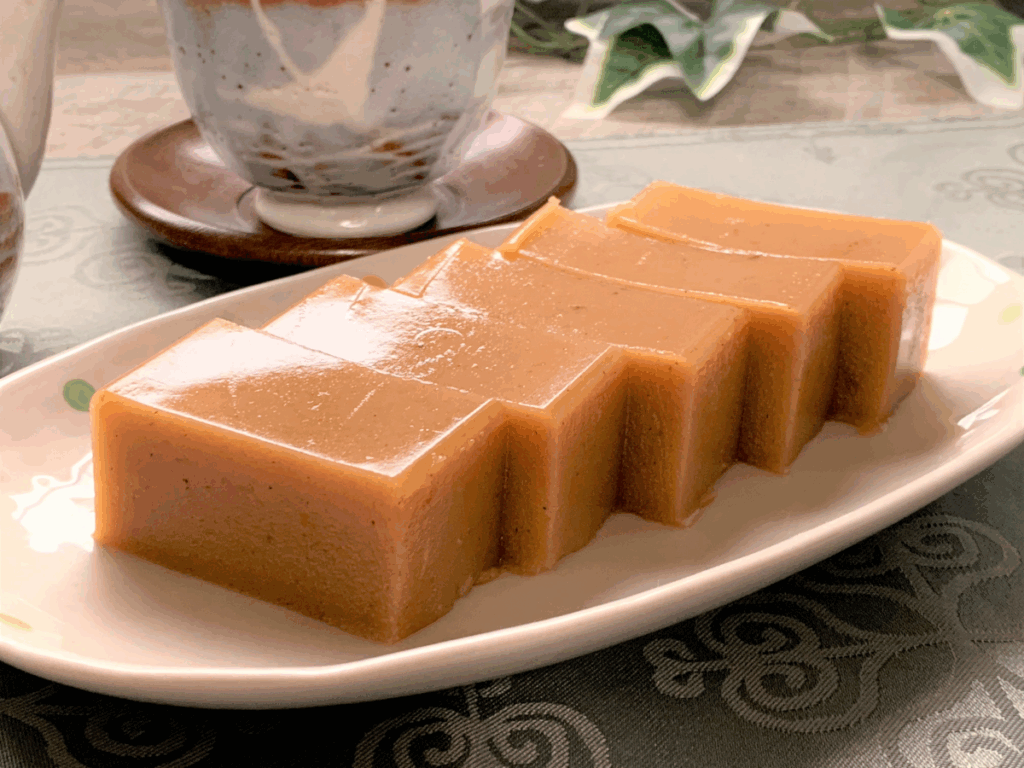
Persimmons also shine in the world of Japanese confections, or wagashi, which emphasize harmony with the seasons.
- Kaki Yokan: A jelly-like sweet made with persimmon puree, often combined with red bean paste. Its translucent orange color reflects the glow of autumn.
- Kaki Daifuku: A creative variation of the popular mochi sweet, where soft rice cakes are filled with persimmon paste or even fresh persimmon pieces.
- Kaki Manju: A baked sweet shaped like a persimmon, filled with bean or chestnut paste, symbolizing the harvest.
These sweets are not only delicious but also visually beautiful, designed to evoke the feeling of autumn. They are particularly popular during momiji-gari, or autumn leaf-viewing, when people gather to enjoy seasonal landscapes and foods.
Western-Inspired Persimmon Desserts
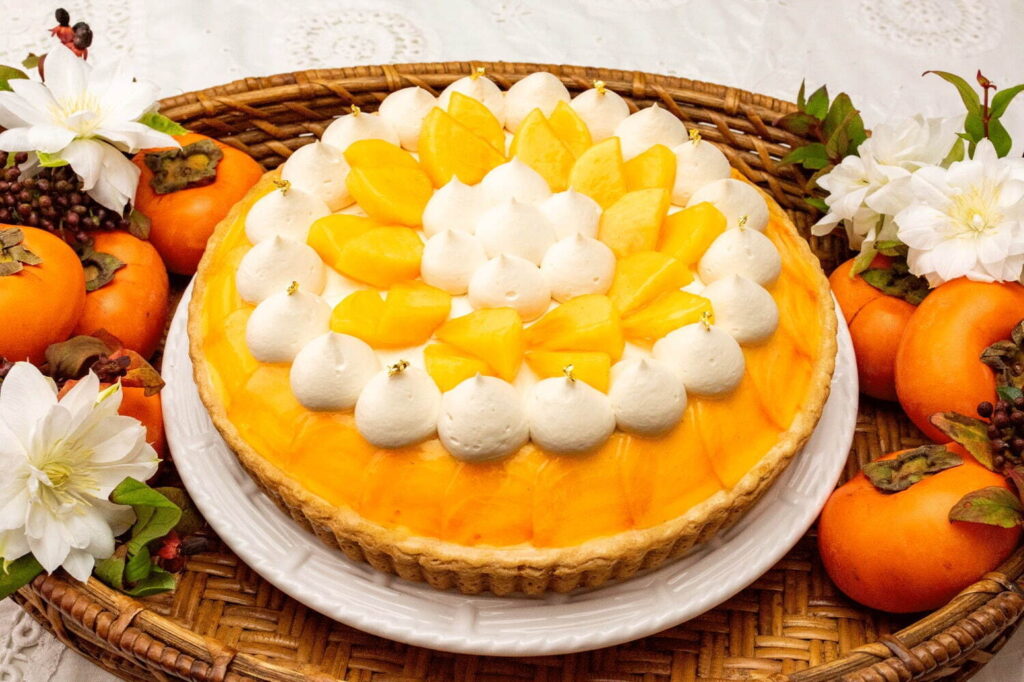
Like many seasonal fruits in Japan, persimmons have been incorporated into Western-style desserts. Cafés and bakeries create persimmon tarts, cakes, and puddings, which highlight the fruit’s natural sweetness. Persimmon cheesecakes and mousses are also popular, offering a creamy contrast to the fresh, juicy texture of the fruit.
In some regions, persimmon jam is made to spread on toast or pair with yogurt, extending the flavor of autumn into the colder months. The adaptability of persimmons shows how Japanese culinary culture is constantly evolving while honoring tradition.
Regional Persimmon Culture
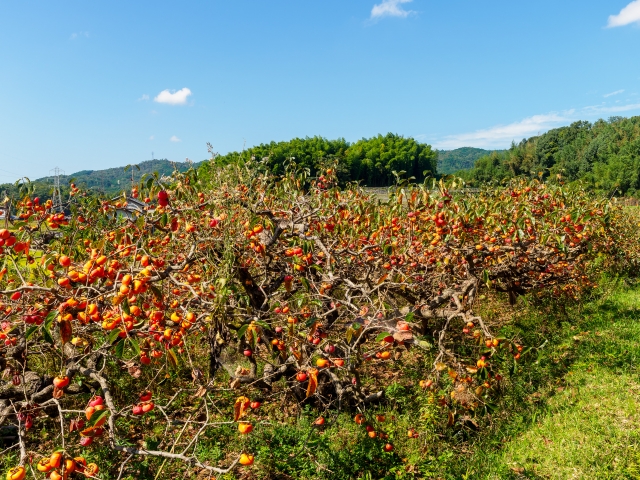
Certain regions of Japan are particularly famous for persimmons. Nara Prefecture, for example, is considered the birthplace of persimmon cultivation in Japan and remains a major producer. Gifu and Wakayama Prefectures are also renowned for their high-quality fruit.
In some towns, festivals are held in honor of persimmons, where visitors can experience hoshigaki-making, taste regional dishes, and purchase local specialties. These events highlight how persimmons are not just food but also a source of community pride and cultural identity.
Symbolism in Art and Literature
Persimmons are a frequent subject in Japanese art and literature. Famous haiku poets like Matsuo Basho and Masaoka Shiki referenced persimmons in their works, often using the fruit as a metaphor for simplicity, ripeness, or the fleeting nature of life. In Zen paintings, persimmons symbolize both aesthetic beauty and spiritual simplicity, reflecting the philosophy of finding profundity in everyday objects.
Final Thoughts
For travelers exploring Japan in autumn, persimmons offer more than just a seasonal treat—they provide a cultural journey. From the rustic charm of hoshigaki drying in the countryside to the refined elegance of persimmon wagashi in Kyoto, persimmons reveal the Japanese ability to celebrate nature’s gifts through food, art, and ritual.
To taste a persimmon in Japan is to experience not only the flavor of autumn but also centuries of tradition and creativity. Whether enjoyed fresh from the market, as part of a traditional meal, or in a delicate sweet with tea, persimmons embody the warmth, abundance, and artistry of Japanese culture.
In the glow of autumn’s colors, the humble kaki shines as one of Japan’s most treasured fruits, reminding us that beauty and meaning often lie in the simplest things.
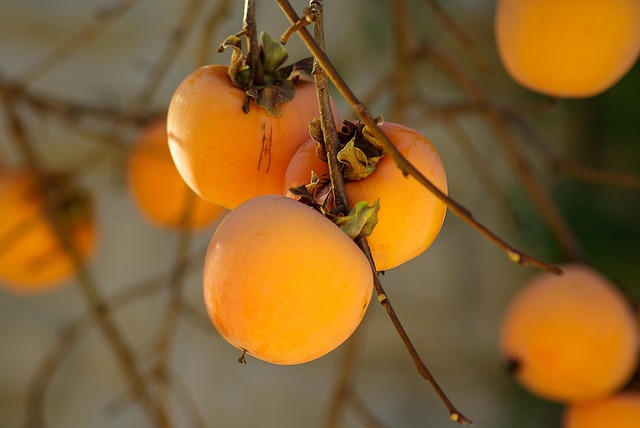


comment